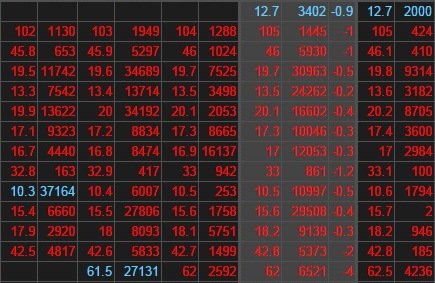The Vietnamese stock market on Wednesday continued its downward trend when the southern and northern bourses lost their resistance levels of 550 points and 81 points, respectively, after dropping 30 points in March this year.
The benchmark VN-Index of the Ho Chi Minh City Stock Exchange lost 12.22 points, or 2.22 percent, to close at 538.91 points, while the HNX-Index of the Hanoi Stock Exchange dropped 1.8 points, or 2.19 percent, to 80.47 points.
The red color indicating losing stocks spread on a large scale on both markets, with 198 losers (out of 307 listed stocks) and 156 losers (out of 369 listed stocks) on the southern and northern floors, respectively.
Both floors saw many blue-chips slip into red, such as DCM, VNM, VIC, SSI, MBB, HAG, and PVS, during the 225-minute trading session.
Phan Dung Khanh, director of investment consultancy with Maybank Kim Eng securities firm, said the main cause of the prolonged decline since March is dollar exchange rate fluctuations and the mass selling of foreign investors, which will be a big obstacle to the recovery of the stock market at this time.
The drop could be caused by the margin call of investors when the VN-Index fell below the 550-point threshold, Khanh said.
"In the morning, the market development was normal, but from the early afternoon when the VN-Index plunged below 550 points, the number of sales rose simultaneously,” Khanh said.
“The resistance level of 550 points is the one a lot of securities firms set for investors to pay back their loans.”
As a result, when the market went down below this level, investors would be forced to sell to preserve capital, Khanh added.
Minh Dang, a local investor who has five years of experience in the local market, told news website VnExpress that the decline of the April 1 session signified that more descents will come this month. The reason is that the uptrend is still very weak given low demand, while the downward trend is stronger thanks to ample supply, Dang said.
After setting a peak in the first quarter of this year with a rally on March 1, the local stock market stayed bearish for the remaining sessions ending on March 30.
The VN-Index was close to the lowest level since the beginning of the year with continuously reduced liquidity and the mass selling of foreign investors in the last week of March.
The index lost more than 40 points while the HNX-Index lost about three points last month.
With the continuous decline, hundreds of stocks in both markets hit the bottom in the preceding three months.
In addition to the fact that foreign investors have become net sellers in the last two weeks, the liquidity has continued to decline in recent weeks.
Statistics show that investors have continually withdrawn money out of the Market Vectors Vietnam ETF (VNM) fund in recent times.
VNM is an exchange-traded fund incorporated in the U.S. with objectives to replicate as closely as possible the price and yield performance of the Market Vectors Vietnam Index comprising publicly traded companies that are domiciled and primarily listed in Vietnam or that generate the majority of their revenues in the Southeast Asian country, according to U.S.-based Van Eck Associates Corp.
After withdrawing $17.78 million on March 19, investors continued to do so with nearly $15 million four days later, and $7.73 million on March 25 and 26.
This is considered a highly unusual move of foreign investors as compared with the previous year, as the first quarter often sees quite strong inward cash flows from them, experts said.
Foreigners conducted a net withdrawal of $26.25 million in March alone.
In the first three months of this year, the VNM attracted nearly $18.5 million, while last year the amount of capital channeled into the fund was nearly $80 million.
Like us on Facebook or follow us on Twitter to get the latest news about Vietnam!




















































